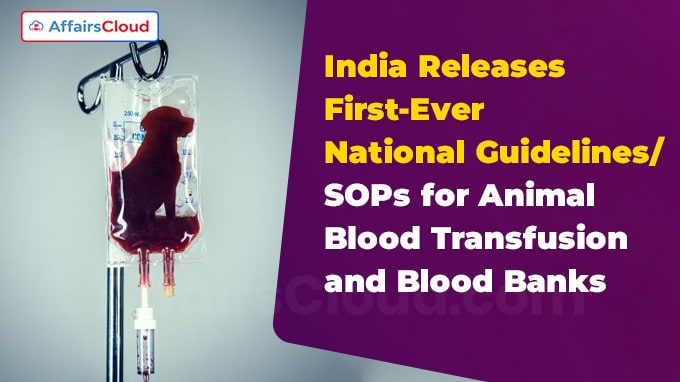 In August 2025, the Department of Animal Husbandry and Dairying (DAHD) under the Ministry of Fisheries, Animal Husbandry and Dairying (MoFAH&D) released India’s first comprehensive national “Guidelines and Standard Operating Procedures (SOPs) for Animal blood transfusion and blood banks”.
In August 2025, the Department of Animal Husbandry and Dairying (DAHD) under the Ministry of Fisheries, Animal Husbandry and Dairying (MoFAH&D) released India’s first comprehensive national “Guidelines and Standard Operating Procedures (SOPs) for Animal blood transfusion and blood banks”.
Exam Hints:
- What? Guideline for animal blood transfusion released
- Released by: DAHD, MoFAH&D
- Why? To improve standards for donor screening, blood matching, typing etc
- Key Provisions: State-regulated blood banks, donor eligibility, voluntary donations, One Health integration, SOPs, NVBBN roadmap, training modules
- Innovations: Mobile blood collection units, preservation techniques, mobile app for donor-recipient matching.
About National Guidelines for Veterinary Blood Transfusion:
Current Scenario: In India, most animal blood transfusions have so far been performed in emergency situations without SOPs for donor screening, blood typing, or storage.
Aim: The DAHD released comprehensive guidelines for veterinary blood transfusion services, aimed at bridging a critical gap in emergency animal healthcare.
Collaborative Development: The guidelines were formulated after extensive consultations with the Veterinary Council of India(VCI), veterinary universities, Indian Council of Agricultural Research (ICAR) institutes, and State Governments (SG).
- The framework is designed to align India’s veterinary transfusion practices with international best standards.
Key Provisions: The new guidelines require blood typing and cross-matching to prevent adverse reactions, set donor eligibility criteria including health and vaccination standards, and promote voluntary donations with informed consent through a Donor Rights Charter.
Key Highlights of the Guidelines & SOPs:
State-Regulated Blood Banks: Establishment of veterinary blood banks with biosafety-compliant infrastructure at the state level.
Blood Compatibility: Mandatory blood typing and cross-matching to prevent incompatibility reactions.
Donor Eligibility: Criteria covering health, vaccination, age, weight, and disease screening norms.
Voluntary Donations: Emphasis on non-remunerated donations with informed consent via a Donor Rights Charter.
Integration: Incorporation of One Health principles to manage zoonotic risks.
Procedures: SOPs, forms, and checklists for donor registration, transfusion monitoring, and adverse reaction reporting.
Future plans:
Roadmap: It lays out a roadmap for a National Veterinary Blood Bank Network (NVBBN) featuring digital registries, real-time inventory tracking and an emergency helpline.
- Training modules for veterinary students, postgraduate programmes, and continuing education for practitioners are also included.
Innovations: Future innovations encouraged under the guidelines include mobile blood collection units, preservation techniques for rare blood types, and mobile applications for donor-recipient matching.
Livestock of India:
Livestock Sector: India’s livestock sector comprises over 537 million animals, while companion animals number more than 125 mn.
- The combined sector contributes 5.5% to national Gross Domestic Product (GDP) and over 30% to agricultural GDP, supporting food security and rural livelihoods.
About Veterinary Council of India(VCI):
President – Dr D C Verma
Headquarters – New Delhi, Delhi
Established – 1984




